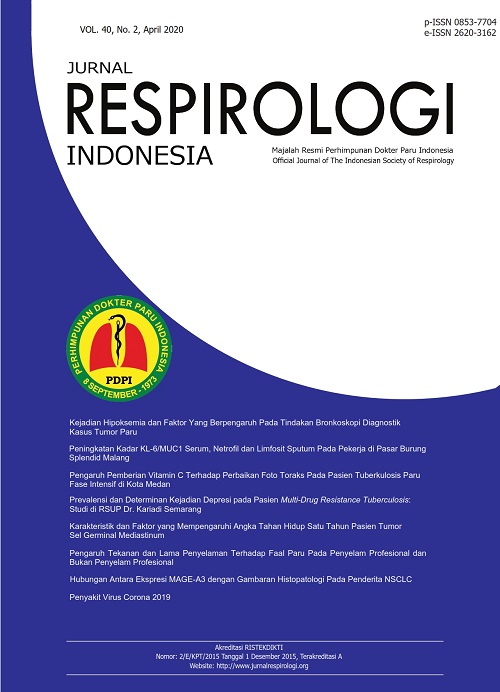The Role of Pressure and Duration of Dive on Lung Physiology in Professional and Non-Professional Divers
DOI:
https://doi.org/10.36497/jri.v40i2.104Keywords:
non-professional divers, professional divers, FVC, FEV1, FEV1 /FVCAbstract
Backgrounds: Professional divers have a greater lung volume than non-professional divers in higher force vital capacity (FVC) and force expiratory flow in 1 second (FEV1) values. The purpose of this study is to analyse the effect of pressure and duration of diving on changes in lung physiology in professional divers and non-professional divers. Methods: This is a cross sectional study on the personnel of the Indonesian Navy Dislambair Koarmada II Surabaya and RSAL personnel of dr. Ramelan Navy Hospital in Lakesla Surabaya in March-April 2019. Samples was collected with purposive sampling. This study used unpaired subjects with the independent t-test statistic analysis if the data is normally distributed and the Mann-Whitney U test if the data is not normally distributed Results: There was a significant difference in the professional divers group compared to non-professional divers group in the values of FVC (P=0.042) and FEV1 (P=0.040) at 1.3 ATA for 10 minutes and the FEV1 (P=0.049) for 20 minutes. No significant differences in FVC (P=0.092) at 1.3 ATA pressure for 20 minutes. There were no significant differences in FVC (P=0.865), FEV1 (P=0.659) at 1.5 ATA pressure for 10 minutes and FVC (P=0.858) and FEV1 (P=0.857) for 20 minutes. Conclusions: The different pressure in non-professional group could reduce the FEV1 value. There was a difference in the FVC value of the professional diver group and non-professional divers at a pressure of 1.5 ATA for 10 minutes. (J Respir Indo. 2020; 40(2): 103-12)Downloads
References
Lembaga Kesehatan Angkatan Laut. Ilmu Kesehatan Hiperbarik. In: Lembaga Kesehatan Angkatan Laut, ed. Ilmu Kesehatan Penyelaman Dan Hiperbarik. 3rd ed. Surabaya: Lembaga Kesehatan Angkatan Laut; 2016. p. 3-56
United States Navy. U.S. Navy Diving Manual. Washington; 2017
Lumb AB. High pressure and diving. In: Lumb AB Pearl AG, ed. NUNN’S Applied Respiratory Physiology. 8th ed. London: Elsevier; 2017. p. 190-6
Ilmi MI, Yunus F, Suryokusumo MG, Damayanti T, Samoedro E, Nazaruddin AM NF. Comparison of lung function values of trained divers in 1.5 ATA hyperbaric chamber after inhaling 100% oxygen and regular air: a crossover study. Adv Respir Med. 2017;85:233-8
Tetzlaff K. Short term and long term effects of diving on pulmonary function. Eur Respir Rev. 2017;26:160–9
Thorsen E, Segadal K, Stuhr LEB, et al. No changes in lung function after a saturation dive to 2.5 MPa with intermittent reduction in PO2 during decompression. Eur J Appl Physiol. 2006;98:270–5
Lehnigk B, Jorres RA, Elliott DH, et al. Effects of a single saturation dive on lung function and exercise performance. Int Arch Occup Environ Health. 1997; 69:201–208.
Crosbie WA, Clarke MB, Cox RAF, et al. Physical characteristics and ventilatory function of 404 commercial divers working in the North Sea. Br J Ind Med. 1977;34: 19–25
Crosbie WA, Reed JW, Clarke MC. Functional characteristics of the large lungs found in commercial divers. J Appl Physiol Respir Environ Exerc Physiol. 1979;46:639–45
Bouhuys A, Beck GJ. Large lungs in divers?. J Appl Physiol Respir Environ Exerc Physiol. 1979;47:1136–7
Crosbie WA, Reed JW, Clarke MC. Functional characteristics of the large lungs found in commercial divers. J Appl Physiol Respir Environ Exerc Physiol. 1979;46: 639–45
Fitz-Clarke JR. Mechanics of airway and alveolar collapse in human breath-hold diving. Respir Physiol Neurobiol. 2007;159:202–10
Thorsen E, Segadal K, Kambestad BK, et al. Divers’ lung function: small airways disease?. Br J Ind Med. 1990;47:519–23
Tetzlaff K, Friege L, Reuter M, et al. Expiratory flow limitation in compressed air divers and oxygen divers. Eur Respir J. 1998;12:895–9
Merkus PJFM, Quanjer PH. Expiratory flow limitation in divers. Eur Respir J. 1999; 13:1496–7
Reuter M, Tetzlaff K, Steffens JC, et al. Functional and high-resolution computed tomographic studies of divers’ lungs. Scand J Work Environ Health. 1999;25:67–74
Adir Y, Shupak A, Laor A, et al. Large lungs in divers: natural selection or a training effect?. Chest. 2005;128:224–8
Davey IS, Cotes JE, Reed JW. Relationship of ventilatory capacity to hyperbaric exposure in divers. J Appl Physiol Respir Environ Exerc Physiol. 1984;56:1655–8
Sekulic D, Tocilj J. Pulmonary function in military divers: smoking habits and physical fitness training influence. Mil Med. 2006;171:1071–5
Skogstad M, Thorsen E, Haldorsen T. Lung function over the first 3 years of a professional diving career. Occup Environ Med. 2000;57:390–5
Downloads
Published
Issue
Section
License
- The authors own the copyright of published articles. Nevertheless, Jurnal Respirologi Indonesia has the first-to-publish license for the publication material.
- Jurnal Respirologi Indonesia has the right to archive, change the format and republish published articles by presenting the authors’ names.
- Articles are published electronically for open access and online for educational, research, and archiving purposes. Jurnal Respirologi Indonesia is not responsible for any copyright issues that might emerge from using any article except for the previous three purposes.
















